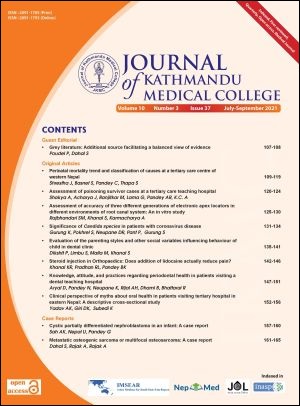Perinatal mortality trend and classification of causes at a tertiary care centre of western Nepal
DOI:
https://doi.org/10.3126/jkmc.v10i3.41206Keywords:
Classification, International classification of diseases, Perinatal death, StillbirthAbstract
Background: Identifying causes of perinatal death is important to reduce perinatal mortality rate.
Objectives: To determine trend of perinatal mortality rate (PMR), ascertain causes, and find out changes in causes of death over period of seven years.
Methods: This retrospective study, conducted after ethical approval, included stillbirths and early neonatal deaths at Manipal teaching hospital from April 2014 to April 2021, after 28 weeks of gestation or of foetuses weighing more than 1000 grams. Perinatal mortality rate of each year was calculated. Cause of death was assigned according to International Classification of Disease – Perinatal Mortality classification. Data analysis was done to find out trends and causes of perinatal mortality using SPSS v.21. Frequency and percentages were used to calculate causes of deaths.
Results: Perinatal mortality rate decreased from 35.5 to 21.1 per 1000 births over seven years. Antepartum hypoxia (103, 45%) was commonest cause of antepartum deaths, commonly associated with maternal medical conditions. This remained as main cause of antepartum death over years. Acute intrapartum events resulted in three-fourths of intrapartum deaths; were associated with complications of labour and delivery. Decline in this has resulted in overall decrease in intrapartum deaths. Low birth weight and prematurity (73, 42.2%) was the common cause of neonatal deaths and has remained same over years.
Conclusion: Perinatal mortality has decreased over years. Antepartum hypoxia as cause of antepartum deaths and prematurity as cause of neonatal deaths remained same over years. There is decrease in intrapartum deaths due to declining acute intrapartum events.
Downloads
Downloads
Published
How to Cite
Issue
Section
License
Copyright © Journal of Kathmandu Medical College
The ideas and opinions expressed by authors or articles summarized, quoted, or published in full text in this journal represent only the opinions of the authors and do not necessarily reflect the official policy of Journal of Kathmandu Medical College or the institute with which the author(s) is/are affiliated, unless so specified.
Authors convey all copyright ownership, including any and all rights incidental thereto, exclusively to JKMC, in the event that such work is published by JKMC. JKMC shall own the work, including 1) copyright; 2) the right to grant permission to republish the article in whole or in part, with or without fee; 3) the right to produce preprints or reprints and translate into languages other than English for sale or free distribution; and 4) the right to republish the work in a collection of articles in any other mechanical or electronic format.




